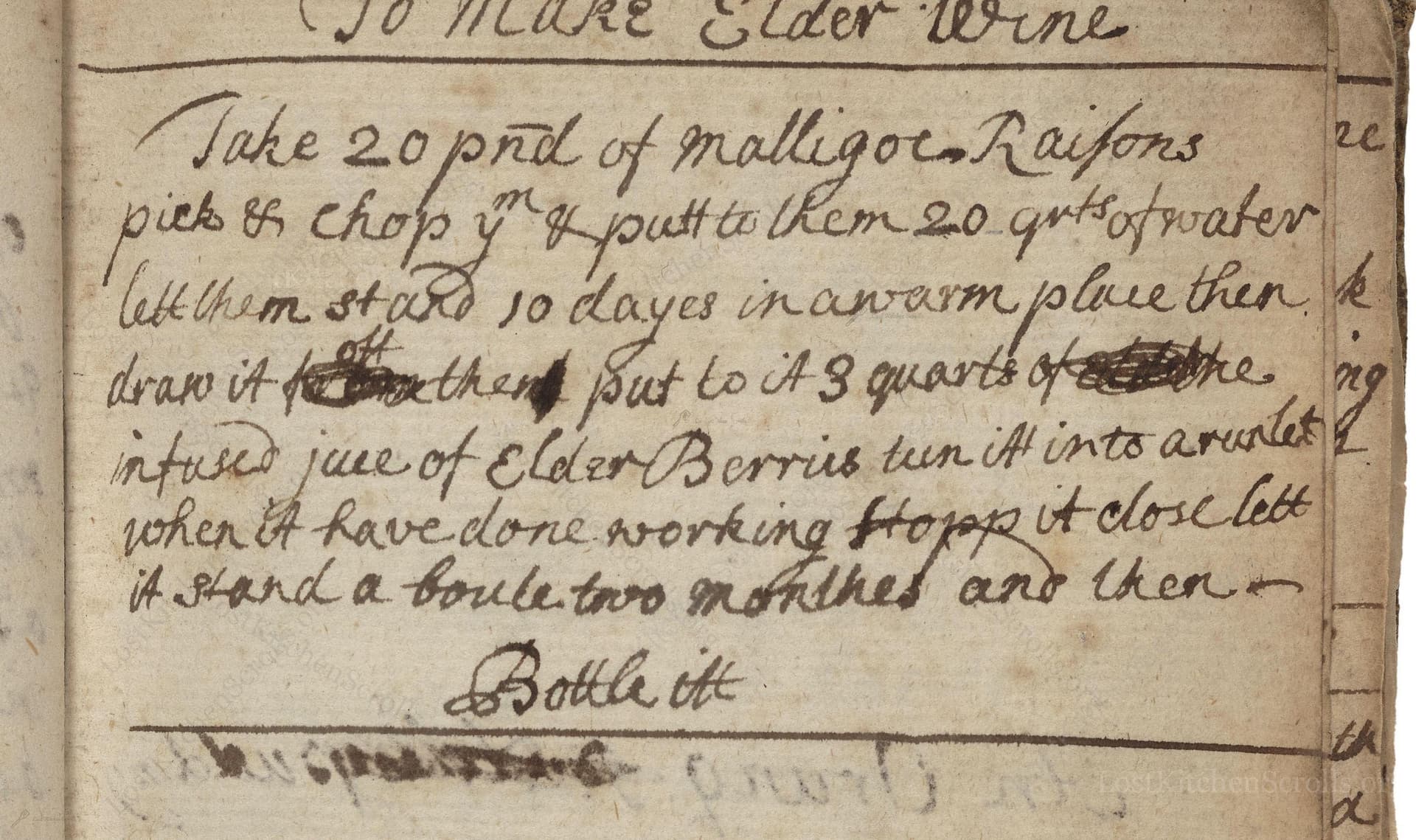To Make Elder Wine
From the treasured pages of Medicinal and cookery recipes of Mary Baumfylde
Written by Mary Baumfylde

To Make Elder Wine
"Take 20 pnd of malligo. Raisons pick & chop ym & putt to them 20 qrts of water lett them stand 10 dayes in a warm place then draw it togather. Put to it 3 quarts of the infused juice of Elder Berries tun it into a rundlet & when it have done working stopp it close lett it stand a bouletwo Monthes and then Bottle itt"
Note on the Original Text
This recipe was written in the concise, practical style characteristic of early modern English manuscript cookery. Spellings were phonetic and idiosyncratic—‘lett them stand 10 dayes’, ‘draw it togather’, or ‘bottle itt’—reflecting regional pronunciation and a lack of standardized spelling before the 18th century. Measures (such as 'pnd' for pounds or 'qrts' for quarts) were familiar to the intended audience—here about 450 grams per pound and 1.14 liters per quart (imperial). The prose is direct, assuming a working knowledge of winemaking and omitting specific instructions about fermentation management—skills taken for granted among experienced housekeepers of the period.

Title
Medicinal and cookery recipes of Mary Baumfylde (1626)
You can also click the book image above to peruse the original tome
Writer
Mary Baumfylde
Era
1626
Publisher
Unknown
Background
A sumptuous journey into early 17th-century English cookery, this delightful volume offers a tantalizing glimpse into the recipes, flavors, and culinary secrets that once graced aristocratic tables. Prepare for a taste of history, presented with wit and wisdom!
Kindly made available by
Folger Shakespeare Library
This recipe is drawn from an early 18th-century English manuscript, attributed to Mary Baumfylde, whose household records offer a vivid window into domestic life between 1626 and the mid-18th century. Wine making in England was then commonly a home practice, bringing autumnal fruits like elderberries into the cellar for both their medicinal and convivial qualities. Elder wine, counted both as a medicinal tonic and a festive beverage, was prized for its warming properties. Elderberry was valued for more than taste: it was believed to ward off winter ills and strengthen the blood, typical of the period’s blending of culinary and health traditions. The recipe reflects the English gentry’s resourcefulness and self-sufficiency—Mary’s kitchen was as much a pharmacy and winery as a place for daily meals.

In Baumfylde’s day, large wooden tubs or earthenware jars would be used for steeping the chopped raisins and water in a warm pantry or scullery. Fermentation vessels—rundlets or small casks—were essential for the secondary fermentation. Juice was extracted by pounding and straining berries in muslin cloths or sieves. Once fermentation waned, the wine was transferred to clean bottles, sealed with cork or wax to prevent spoilage. Wooden spoons, knives for chopping, and bottles of robust blown glass rounded out the cellar’s toolkit. Today, modern equivalents include sanitized plastic or glass fermenters, nylon straining bags for fruit, and airlock systems to manage fermentation safely and efficiently.
Prep Time
30 mins
Cook Time
0 mins
Servings
25
We've done our best to adapt this historical recipe for modern kitchens, but some details may still need refinement. We warmly welcome feedback from fellow cooks and culinary historians — your insights support the entire community!
Ingredients
- 20 lbs Malaga raisins (or substitute sultanas or dark, seedless raisins)
- 5 gallons water
- 3 quarts elderberry juice (freshly extracted or bottled unsweetened)
- Optional: granulated sugar (if sweetness/securing fermentation is needed)
- Optional: wine yeast (to ensure consistent fermentation)
Instructions
- To make this old-fashioned elderberry wine today, you’ll start with 20 lbs of sweet, dark raisins (Malaga raisins are traditional but sultanas or regular are fine).
- Chop them coarsely and combine with 5 gallons of warm water in a large, sanitized fermenting vessel.
- Let the mixture steep and ferment gently for 10 days in a warm place, stirring daily for even fermentation.
- Then, strain the liquid.
- Add about 3 quarts of elderberry juice (about 3 quarts—made by steeping or simmering fresh elderberries, or from bottled juice if available).
- Transfer it all to a sanitized fermentation cask or carboy.
- After it finishes fermenting (when bubbling stops), seal it tightly and let it mature for 1–2 months (the original says about two months).
- Finally, bottle the finished wine, sealing each bottle well.
- Imbibe responsibly—the result is rich, fragrant, and reminiscent of port.
Estimated Calories
180 per serving
Cooking Estimates
It takes about 30 minutes to chop the raisins and prepare the ingredients. There is no actual cooking, but the mixture needs to ferment and mature over several weeks. Each glass of elderberry wine will have about 180 calories. This recipe makes 25 servings.
As noted above, we have made our best effort to translate and adapt this historical recipe for modern kitchens, taking into account ingredients nowadays, cooking techniques, measurements, and so on. However, historical recipes often contain assumptions that require interpretation.
We'd love for anyone to help improve these adaptations. Community contributions are highly welcome. If you have suggestions, corrections, or cooking tips based on your experience with this recipe, please share them below.
Join the Discussion
Rate This Recipe
Dietary Preference
Main Ingredients
Culinary Technique

Den Bockfisch In Einer Fleisch Suppen Zu Kochen
This recipe hails from a German manuscript cookbook compiled in 1696, a time whe...

Die Grieß Nudlen Zumachen
This recipe comes from a rather mysterious manuscript cookbook, penned anonymous...

Ein Boudain
This recipe comes from an anonymous German-language manuscript cookbook from 169...

Ein Gesaltzen Citroni
This recipe, dating from 1696, comes from an extensive anonymous German cookbook...
Browse our complete collection of time-honored recipes



